Home | Airshows | The Hangar | Nostalgia | Links
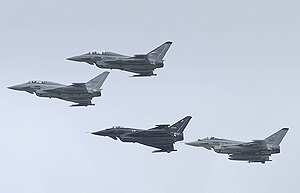 Typhoon
to the four
Typhoon
to the four
Farnborough International 2002, 22 - 28 July
Gary Parsons reports on the first 21st Century SBAC show
|
You
get a Hoon with Typhoon
|
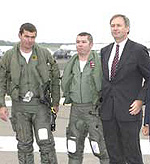 |
|
Four Eurofighters - make that Typhoons as soon as they landed - took to the skies above Farnborough when three developmental models met up with the first instrumented production aircraft (IPA 1) on Tuesday 23 July - a sight that had never been seen before! On hand to celebrate the event were UK Defence Secretary Geoff Hoon, the Chief of Air Staff, Air Chief Marshall Sir Peter Squire, the Chief of Defence Procurement, Sir Robert Walmsley and Eurofighter CEO Filippo Bagnato. During the ceremonies, Hoon said, "Typhoon will be the most sophisticated aircraft the RAF has ever flown. It will provide a step change in the RAF's ability in both air superiority and air defence. It will be the backbone of the fast jet combat fleet for many years to come and will help us meet tomorrow's uncertain challenges." IPA 1 was flown in by BAE Systems Eurofighter Project Pilot Craig Penrice with RAF Wing Commander David 'Charlie' Chan in the backseat. Chan has been selected to be the first officer commander of the RAF's first Typhoon unit, 17 Squadron, which is to be the Typhoon Operational Evaluation Unit (OEU). "It is a great privilege to have been selected to command 17 Squadron and to fly the RAF's newest and most exciting aircraft," said Wing Commander Chan. "I can't wait to get started." He's certainly waited quite a while! |
Farnborough International was once again the place to be, and do business. So said the SBAC, which claimed an independent report showed that the calibre of visitors was high, but the reduction in business announced accurately reflected the current market place. There was no denying that numbers were down - easy access into the show on all days was in marked contrast to previous years, although one must credit the organisation which was well-marshalled and efficient. It may have been affected by the Fairford experience, as warnings of high security checks may have deterred many who suffered in the long queues at RIAT, but although security was tight it was never intrusive.
 David
Norriss, Director of Marketing and Business Development for the SBAC,
said "The key to the success of any trade exhibition is the quality
of visitors it attracts. Around 150,000 people attended the show on its
five trade days. We estimate a quarter of a million people will have attended
Farnborough International 2002."
David
Norriss, Director of Marketing and Business Development for the SBAC,
said "The key to the success of any trade exhibition is the quality
of visitors it attracts. Around 150,000 people attended the show on its
five trade days. We estimate a quarter of a million people will have attended
Farnborough International 2002."
|
Virgin
in name only?
|
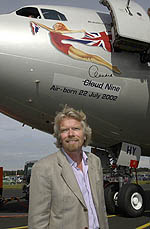 |
|
Sir Richard Branson, Virgin Atlantic's chairman arrived at Farnborough International 2002 on the airline's first Airbus A340-600 waving the Union Jack out of the cockpit window. The aircraft, which was full of guests and media, departed from London Heathrow after the early morning VIP party where the supermodel Claudia Schiffer had named the aircraft "Claudia Nine". It wasn't the first time that Branson has used such PR in launching an aeroplane, and it probably wasn't Claudia's first PR job either. |
 |
September 11th has had, and will continue to have, an impact on the aerospace industry. Farnborough signalled a return to confidence in growth, as traffic figures are now showing signs of recovery to pre-9/11 levels, and exhibitors and visitors at FI2002 saw how the global aerospace industry is coming back from this horrific day and were able to have a glimpse into its future.
David Marshall, SBAC Director General, said "Farnborough International is the shop window for the world's aerospace industry to display its wide range of products and capabilities and the overwhelming evidence of the take-up by exhibitors for this year's event and the high calibre of visitors confirm the status of Farnborough International as the world's premier aerospace business event."
But, many major players were only present in the vast trade halls, not on the flightline. Boeing just had a baby 737 on show, and the Russians were absent - mainly due to the Swiss threat (see our Berlin report) but many suspected they wouldn't have turned up anyway. Stars were few, and we'd seen it all before - Typhoon, F/A-18F and Gripen for the military, Airbus A318 (shortest in the Airbus range) and A340 (longest) from the airline industry. Just think what an impact JSF/F-35 would have made with the interest currently being shown from European nations, but we had to be content with a plastic replica once more. It's understandable we may never see F-22 due to its lack of export potential, but Lockheed's baby project is another matter.
Fantastic flying
Trade day
flying was restricted to two hours, but was compact and highly entertaining
with some of the best displays seen in recent times. Yes, we missed the
thrust-vectoring Flanker but Boeing test pilot Ricardo Treven in the F/A-18F
made up for that with a Su-27-esque routine that commenced with a 'cobra'
and continued with many energy-sapping turns that belied the size of this
big fighter. The aircraft were in the markings of VFA-41 'Black Aces'
and VFA-102 'Diamondbacks' (these two units having recently transitioned
from the F-14 Tomcat) and were due to be  delivered
to the US Navy units at NAS Lemoore, CA, after the show.
delivered
to the US Navy units at NAS Lemoore, CA, after the show.
Typhoon was as impressive as ever, Chris Worning performing most of the week's displays (Italian pilot Maurizio Cheli was also on hand). Worning was quoted as saying "It's like taking a tiger by the tail", referring to Typhoon's lightning acceleration on take-off.
|
Flying
stars
|
 |
 |
 |
 |
 |
 |
 |
Providing stiff competition for the new generation of fighters was the F-16C demonstration pilot who really squeezed every last 'g' out of the ageing airframe - it made the European displays look almost tame in comparison and showed that there's life left in the old dog yet. It's ironic that 21st Century Farnborough should be won over by an aircraft designed in the early seventies, long since its potential should have been realised, but emphasises the reluctance for the manufacturers to bring their new toys to play with. Gripen was willing, but showed that it is no more than a poor man's Eurofighter and lacks the manoeuvrability of its more modern rival. A curious addition to each day's flying schedule was Spitfire XIX PS853, not exactly cutting edge, but welcome all the same.
Debutantes
Making an international debut was Aero's L-159B ALCA (Advanced Light Combat Aircraft), which only flew for the first time on 1 June. A dual-purpose training and combat package, it's basically a dual-seat L-159A with avionics supplied by Boeing and a modern Honeywell ITEC F124 engine and is aimed squarely at the European combat trainer market.
 Literally
dropping in at short notice was Pilatus's new PC-21
trainer - it finished its test programme on Thursday 18 July and a snap
decision saw it taken directly to Fairford and RIAT, then onto Farnborough
on Sunday ready for the week's trade days. Utilising its considerable
experience of turboprop training aircraft, such as the PC-7 MkII and PC-9,
Pilatus has designed a completely new aircraft, featuring a 1,600 SHP
Pratt & Whitney PT6A-68B engine giving a top speed at low level of
330 kts. It has been designed with MFD displays and is intended to provide
a lead-in trainer that is compatible with tomorrow's high-tech fighters
such as Gripen, Rafale and Typhoon.
Literally
dropping in at short notice was Pilatus's new PC-21
trainer - it finished its test programme on Thursday 18 July and a snap
decision saw it taken directly to Fairford and RIAT, then onto Farnborough
on Sunday ready for the week's trade days. Utilising its considerable
experience of turboprop training aircraft, such as the PC-7 MkII and PC-9,
Pilatus has designed a completely new aircraft, featuring a 1,600 SHP
Pratt & Whitney PT6A-68B engine giving a top speed at low level of
330 kts. It has been designed with MFD displays and is intended to provide
a lead-in trainer that is compatible with tomorrow's high-tech fighters
such as Gripen, Rafale and Typhoon.
Only Russian hardware evident was a Su-25, displayed by a consortium of Israeli company Elbit and TAM of Tbilisi, Georgia. With an all-new glass cockpit, the modernised 'Scorpion' is very much an A-10 match and the upgrade is aimed at the 800+ still in service with Eastern European airforces. Whether they will be able to afford it is another matter.
AgustaWestland
wasn't just concentrating on Apache - it had a new Lynx, the 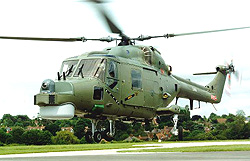 Super
300 (below) on show alongside a Merlin HC3, EH-101
Cormorant and NH-90. The Cormorant was especially
nice to see, fresh from the Agusta factory and en-route to Canada - just
emphasised what we had missed at Waddington.
Super
300 (below) on show alongside a Merlin HC3, EH-101
Cormorant and NH-90. The Cormorant was especially
nice to see, fresh from the Agusta factory and en-route to Canada - just
emphasised what we had missed at Waddington.
American aircraft in the static park would have been warmly welcomed at the previous week's RIAT at Fairford - F/A-18F, S-3B Viking, C-2A Greyhound and E-2C Hawkeye all being the rarer US Navy types that seem to be reluctant to attend regular UK shows in the past few years. Heavily guarded all week, only invited guests were allowed into the compound, but it was good to see the aircraft in these security conscious times. The F-16C sported conformal wing tanks, an effort to increase the range and capability of the multi-role fighter.
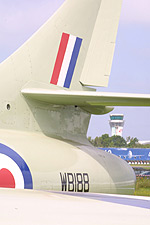 Remembering
its roots
Remembering
its roots
The airfield may be changing dramatically under new owners TAG, but the show still took time to remember its glorious past, history that helped shape the aviation world we know today. On Monday, American born naturalised UK citizen Samuel F Cody was honoured when US exhibitors presented a plaque to be attached to the take off point of his "British Army Aeroplane No 1". The obelisk now stands in the garden of the very first RAF Officers' mess!
Two familiar
names from Farnborough's past returned to the show on Wednesday when Neville
Duke and Peter Twiss visited the show to sign new editions of their autobiographies.
Duke is best remembered as Hawker's chief test pilot, a World Speed Record
holder and for some memorable aerobatic displays in a Hunter at Farnborough
in the 1950s. Twiss is also a former World Speed record holder having
become the first man  to
exceed 1,000mph (1,600kph) in the Fairey Delta 2.
to
exceed 1,000mph (1,600kph) in the Fairey Delta 2.
Publically speaking
Flying on the public days included such favourites as the BBMF, RAF display jets and, of course, the Red Arrows, but little in the way of classic jets - De Havilland's Sea Vixen was present, as were Golden Apple's T-33 and F-86 Sabre, but all remained firmly in the static park. The weather was fabulous for the two public days, making for an enjoyable time for the paying punter, who finally got to see Typhoon display not just once but twice each day, giving a welcome second chance to many photographers who were in the wrong position the first time (or fluffed their shots - no comment! Ed.). Some complained about the double-acts in the day, but we firmly support it if they are the star acts - Waddington's double-act F-15I in 2001 was appreciated by many. As long as the two routines are sufficiently far apart in the day, that is - the two Airbus slots were only two hours apart on both days, too close in our opinion.
 As
usual, the vast trade halls were packed with the latest grommets and widgets
from every corner of the globe, reflecting the cautious optimism that
is creeping back since last September. 2003 will celebrate a century of
powered flight, and it was evident that it will also be a key year for
the industry - more setbacks may push many firms under, as well as create
more mergers of survival.
As
usual, the vast trade halls were packed with the latest grommets and widgets
from every corner of the globe, reflecting the cautious optimism that
is creeping back since last September. 2003 will celebrate a century of
powered flight, and it was evident that it will also be a key year for
the industry - more setbacks may push many firms under, as well as create
more mergers of survival.
But, our
argument remains that there are too many trade shows competing against
each other for the good of the aviation business. Farnborough still claims
to be 'The greatest airshow in the world', but it is certainly far from
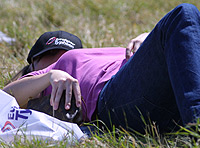 that,
as it has been for a number of years now. Berlin's May show inevitably
stole much of Farnborough's thunder, and likewise some manufacturers waited
until the Hampshire event to announce deals, thus devaluing both events
to a degree. As we said before, one show, rotated through Farnborough,
Paris and Berlin would mean each was the focus for the year, so would
grow stronger and prosper. Has the industry the will to make it so?
that,
as it has been for a number of years now. Berlin's May show inevitably
stole much of Farnborough's thunder, and likewise some manufacturers waited
until the Hampshire event to announce deals, thus devaluing both events
to a degree. As we said before, one show, rotated through Farnborough,
Paris and Berlin would mean each was the focus for the year, so would
grow stronger and prosper. Has the industry the will to make it so?
Farnborough International 2004 will be from 19 - 25 July, unless of course they adopt our revolutionary idea!
Home | Airshows | The Hangar | Nostalgia | Links


